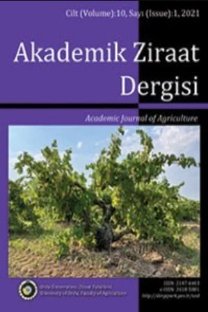Destekleme sulamanın fındığın toplam antioksidan kapasitesi ve fenolik miktarına etkisi
Effect of supplementary irrigation on total antioxidant capacity and phenolic content of hazelnut
___
- Alasalvar, C., Amaral, J. S., Shahidi, F., 2006. Functional Lipid Characteristics of Turkish Tombul Hazelnut (Corylus avellana L.). Journal of Agricultural and Food Chemistry, 54, 10177-10183.
- Alasalvar, C., Shahidi, F., 2009. Tree Nuts: Composition Phytochemicals and Health Effects. Taylor & Francis Group Boca Raton London New York: CRC Press.
- Altun, M., Çelik, S. E, Güçlü, K., Özyürek, M., Erçağ, E., Apak, R., 2013. Total Antioxidant Capacity and Phenolic Contents of Turkish Hazelnut (Corylus avellana) Kernels and Oils. Journal of Food Biochemistry, 37(1): 53-61.
- Amaral, J. S., Casal, S., Citov´a, I., Santos, A., Seabra, R. M., Oliveira, B. P. P., 2006. Characterization of several hazelnut (Corylus avellana L.) cultivars based in chemical, fatty acid and sterol composition. European Food Research and Technology, 222, 274-280.
- Arcan, I., Yemenicioğlu, A., 2009. Antioxidant activity and phenolic content of fresh and dry nuts with or without the seed coat. Journal of Food Composition and Analysis, 22(3): 184-188.
- Crews, C., Hough, P., Godward, J., Brereton, P., Lees, M., Guiet, S., and Winkelmann, W., 2005. Study of the Main Constituents of Some Authentic Hazelnut Oils. Journal Agricultural Food Chemistry, 53(12), 4843– 4852.
- Cristofori, V., Muleo, R., Bignami, C., Rugini, E., 2014. Long term evaluation of hazelnut response to drip irrigation. Acta Horticulturae, 1052, 179-185.
- Contini, M., Baccelloni S., Massantini, R. and Anelli, G., 2008. Extraction of natural antioxidants from hazelnut (Corylus avellana L.) shell and skin wastes by long maceration at room temperature. Food Chemistry, 110(3): 659-669.
- Delgado, T., Malheiro, R., Pereira, J. A., Ramalhosa E., 2010. Hazelnut (Corylus avellana L.) kernels as a source of antioxidants and their potential in relation to other nuts. Industrial Crops and Products, 32(3): 621- 626.
- FAO, 2019. FAOSTAT. (Web page: http://www.fao.org /faostat/en/#data/QC),(Date accessed: 17.04.2019) İslam, A, 2018. Hazelnut culture in Turkey. Akademik Ziraat Dergisi , 7 (2) , 259-266 .
- Kornsteiner, M., Wagner, K.-H., Elmadfa, I., 2006. Tocopherols and total phenolics in 10 different nut types. Food Chemistry, 98(2), 381-387.
- Koyuncu M. A., Islam A., Kucuk M., 2005. Fat and fatty acid composition of hazelnut kernels in vacuum packages during storage, Grasas y Aceites, 56:263- 266
- Krist S., Buchbauer G., Klausberger C., 2008, Lexikon der pflanzlichen Fette und Öle. Springer Verlag, Wien.
- Külahçilar, A., Tonkaz, T., Bostan, S.Z., 2018. Effect of irrigation regimes by mini sprinkler on yield and pomological traits in 'Tombul' hazelnut. Acta Horticulturae, 1226, 301-308.
- Li, H., Parry, J. W., 2011. Phytochemical Compositions, Antioxidant Properties, and Colon Cancer Antiproliferation Effects of Turkish and Oregon Hazelnut. Food and Nutrition Sciences, 02(10): 1142-1149.
- Lipan, L., Moriana, A., López Lluch, D. B., Cano-Lamadrid, M., Sendra, E., Hernández, F., Vázquez-Araújo, L., Corell, M., Carbonell-Barrachina, Á. A., 2019. Nutrition Quality Parameters of Almonds as Affected by Deficit Irrigation Strategies. Molecules, 24(14), 2646.
- Marin, A., Rubio, J. S., Martínez, V., Gil, M. I., 2009. Antioxidant compounds in green and red peppers as affected by irrigation frequency, salinity and nutrient solution composition. Journal of the Science of Food and Agriculture, 89(8), 1352-1359.
- Miraliakbari, H., Shahidi, F., 2008. Antioxidant activity of minor components of tree nut oils. Food Chemistry, 111(2): 421-427.
- Pelvan, E., Alasalvar, C., Uzman, S., 2012. Effects of Roasting on the Antioxidant Status and Phenolic Profiles of Commercial Turkish Hazelnut Varieties (Corylus avellana L.). Journal of Agricultural and Food Chemistry, 60: 1218−1223.
- Pernice, R., Parisi, M., Giordano, I., Pentangelo, A., Graziani, G., Gallo, M., Fogliano, V. and Ritieni, A., 2010. Antioxidants profile of small tomato fruits: Effect of irrigation and industrial process. Scientia Horticulturae, 126(2), 156-163.
- Sahin, S., 2011. Bewertung der licht-induzierten Lipidstabilität von konventionellen und high-oleic Rapsölen supplementiert mit natürlichen Antioxidantien, Yüksek Lisans Tezi, Hamburg University of Applied Sciences, Hamburg
- Sahin, S., Kılıç, Ö, Şengül, S., Perçin, S., 2019. Farklı İllerden Temin Edilen Fındık Zarının Bileşimi ve Antioksidan Etkinliğinin Araştırılması. Ordu Üniversitesi Bilim ve Teknoloji Dergisi, 9 (1): 27- 35.
- Sahin S., Tonkaz T., Oğurlu M. N., Uğurlu Z., 2017. Chemical Composition, Antioxidant Capacity and Phenolic Content of Hazelnut Fruits Grown in Different Countries, IX. International Congress on Hazelnut, 15-19 Ağustos, Samsun
- Schmidt, N., Zinkernagel, J., 2017. Model and Growth Stage Based Variability of the Irrigation Demand of Onion Crops with Predicted Climate Change, Water, 9(9), 693.
- Willcox, J. K., Ash, S. L., Catignani, G. L., 2004. Antioxidants and prevention of chronic disease. Critical Reviews in Food Science and Nutrition, 44(4): 275-295.
- Yang, J., Liu, R. H., Halim, L., 2009. Antioxidant and antiproliferative activities of common edible nut seeds. LWT - Food Science and Technology, 42(1): 1-8.
- ISSN: 2147-6403
- Yayın Aralığı: Yılda 2 Sayı
- Başlangıç: 2012
- Yayıncı: Ordu Üniversitesi Ziraat Fakültesi
Ordu ili Gürgentepe ilçesinde yetiştirilen Çakıldak fındık çeşidinde klon seleksiyonu
Fındıkta kseni ve metakseni: meyve tutumu ve meyve özelliklerine etkisi
Neriman BEYHAN, Hüseyin İrfan BALIK
Fındık zarı ve okside nişasta ilavesinin hamur reolojisi üzerine etkileri
YUSUF DURMUŞ, MÜNİR ANIL, ŞENAY ŞİMŞEK
Arzu SEZER, Yusuf BİLGEN, Ömür DUYAR, Çiğdem KÖSE, Ebru GÜMÜŞ, Tuğba ER
Fındıkta kabuklu ve iç meyve kusurları
Farklı IBA uygulamalarının Corylus colurna L.’nın odun çelikleriyle köklenmesi üzerine etkisi
Ali İSLAM, İsa ÖGER, Selim KARAGÖL, Ali TURAN
Ahmet Semih UZUNDUMLU, Abdulbaki BİLGİÇ, Nur ERTEK
Hüseyin İrfan BALIK, Selda KAYALAK BALIK, Burhan ÖZTÜRK, Sefa GÜN
Corylus türlerinin peyzaj tasarım çalışmalarında kullanılabilirliği
